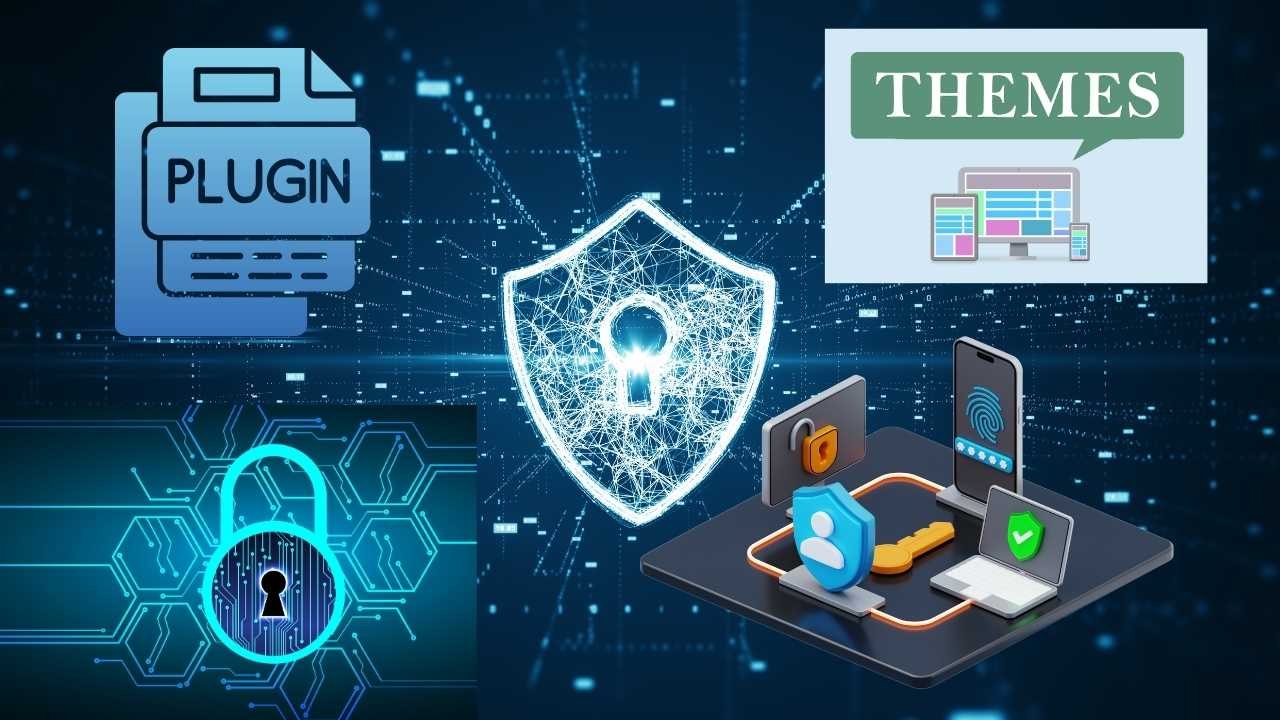Stay ahead of WordPress security threats in 2025. Learn how vulnerabilities in themes and plugins emerge, how to protect your site, and the best practices every developer and author should follow to ensure safety and compliance.
Theme and Plugin Security: What Every WordPress Author Must Know About Vulnerabilities in 2025
Introduction
WordPress powers over 43% of all websites worldwide, and its ecosystem of themes and plugins has made it the most flexible CMS ever built. However, that same flexibility also brings risk. Every year, thousands of websites face hacking attempts due to insecure code, outdated plugins, or poorly managed themes.
As a WordPress author—whether you create themes, plugins, or manage a website—security must be your top priority in 2025. Cyber threats have evolved, AI-powered exploits are emerging, and users expect bulletproof protection.
This guide explores everything you need to know about theme and plugin vulnerabilities, why they happen, and how to safeguard your WordPress products and customers.
1. Why Security Matters More Than Ever in 2025
In 2025, WordPress continues to dominate the small business, e-commerce, and blogging industries. However, with its popularity comes constant targeting by attackers.
According to Wordfence Threat Intelligence, more than 4.6 billion malicious login attempts were detected in 2024 alone. Many of these attacks exploited outdated or poorly coded themes and plugins.
Why This is a Growing Concern
-
Open-source exposure GPL-based code is publicly available—attackers can study it for weak points.
-
Rapid update cycles Frequent WordPress core updates mean plugins/themes must keep up or become incompatible.
-
Third-party dependencies Many products use third-party scripts or APIs, which can introduce vulnerabilities.
-
AI-assisted attacks Hackers now use AI to detect weak code patterns faster than before.
Your theme or plugin isn’t just code—it’s a potential entry point for hackers.
2. The Most Common WordPress Vulnerabilities in Themes & Plugins
Understanding the main types of vulnerabilities helps developers defend against them effectively.
🔹 1. Cross-Site Scripting (XSS)
XSS allows attackers to inject malicious scripts into web pages.
Example: If your theme’s contact form fails to sanitize inputs, hackers can embed JavaScript that steals user data or hijacks sessions.
🔹 2. SQL Injection (SQLi)
Occurs when database queries use unsanitized input, allowing attackers to manipulate queries and extract sensitive information.
🔹 3. Remote Code Execution (RCE)
RCE lets attackers run arbitrary code on your server. A vulnerable plugin with file upload capability could allow malware installation.
🔹 4. Cross-Site Request Forgery (CSRF)
CSRF tricks authenticated users into performing unwanted actions, like changing settings or deleting posts.
🔹 5. Privilege Escalation
When roles and permissions aren’t configured correctly, attackers can gain admin-level access through a low-privilege account.
🔹 6. Insecure APIs or Webhooks
Improperly authenticated APIs can allow external actors to manipulate or access private data.
🔹 7. Outdated Libraries
Themes and plugins often depend on outdated versions of jQuery, Bootstrap, or PHP libraries—creating silent security holes.
3. How Vulnerabilities Enter WordPress Themes and Plugins
Even skilled developers can introduce vulnerabilities unintentionally. Here’s how they typically creep in
-
Insufficient Input Validation Not sanitizing data from users or database queries.
-
Lack of Escaping Output Displaying unescaped user data on the front end allows malicious script execution.
-
Improper File Permissions Leaving directories writable exposes themes/plugins to direct file injection.
-
Hardcoded Credentials Using test credentials or static API keys in distributed code is a critical error.
-
Unverified Third-Party Code Integrating libraries from untrusted sources without security audits.
-
Ignoring Security Nonces Failing to use WordPress nonces (wp_create_nonce(), check_admin_referer()) in admin actions opens the door to CSRF attacks.
Each of these flaws can lead to data leaks, website defacement, or full server compromise.
4. Best Security Practices for WordPress Developers in 2025
To develop secure and trustworthy products, follow these modern best practices.
1. Sanitize, Escape, Validate
Use built-in WordPress functions
- sanitize_text_field()
- esc_html(), esc_attr(), esc_url()
- wp_kses_post() to filter HTML inputs
Always assume user input is untrustworthy.
2. Use Nonces for Verification
Every form or admin action should include a nonce to ensure requests originate from legitimate sessions.
3. Follow the Principle of Least Privilege
Limit permissions. For example, only admins should be able to modify options or upload files.
4. Keep Dependencies Updated
Use tools like Composer, npm, or WP-CLI to monitor dependency versions and known CVEs (Common Vulnerabilities & Exposures).
5. Encrypt and Hash Sensitive Data
Never store plain passwords, API keys, or tokens. Use wp_hash_password() and SSL for all API calls.
6. Perform Security Audits
Run static code analysis using
- WPScan
- PHPStan
- SonarQube
- CodeQL
These detect common security flaws early in the development process.
7. Follow WordPress Coding Standards
Adopt WordPress’s PHPCS (PHP CodeSniffer) standards to ensure consistent, secure coding practices.
8. Harden File Permissions
- Files: 644
- Directories: 755
- Never allow 777 (full write access).
9. Integrate with Security APIs
Modern developers can integrate tools like Wordfence API, Sucuri Scanner, or MalCare for automated vulnerability checks.
10. Practice Responsible Disclosure
If you find a vulnerability, report it responsibly through WP’s Plugin Vulnerability Disclosure Program or use HackerOne channels.
5. How AI and Automation Are Changing WordPress Security
AI isn’t just helping attackers—it’s helping developers too.
1. AI-Powered Code Scanning
Tools now use machine learning to predict potential vulnerabilities based on code patterns before release.
2. Automated Malware Detection
Plugins like Wordfence Intelligence or Patchstack AI Defender use behavioral analysis to detect threats early.
3. AI-Assisted Updates
Automated systems can now roll back vulnerable plugin versions and patch them without manual input.
4. Smart Access Control
AI-driven authentication tools dynamically detect suspicious login attempts and enforce 2FA only when risk increases.
AI transforms the landscape from reactive defense to proactive protection—crucial for 2025’s rapid threat evolution.
6. Security for Theme & Plugin Authors Selling on Marketplaces
If you’re selling on ThemeForest, TemplateMonster, or GPL marketplaces, you must maintain a reputation and trust.
Follow Marketplace Security Guidelines
- Always include a changelog and update log.
- Submit products for security audits before major releases.
- Avoid including demo imports with hardcoded credentials.
- Provide a security disclosure email in your documentation.
- Encourage users to update regularly via auto-update integration.
Marketplaces increasingly suspend or delist products with recurring vulnerabilities. A single exploit can damage your brand.
7. Security Tools Every WordPress Author Should Use
Here are essential tools and frameworks to safeguard your products
Tool | Purpose | Type |
WPScan | Detect vulnerabilities in themes/plugins | CLI/Scanner |
Wordfence | Malware, firewall, and login security | Plugin |
Sucuri Security | Website firewall and malware cleanup | SaaS |
MalCare | One-click malware removal | Plugin |
Patchstack | AI-powered vulnerability management | SaaS |
PHPStan | Static code analysis for PHP | CLI |
Dependabot | Automated dependency updates | GitHub |
Jetpack Protect | Site monitoring and brute force protection | Plugin |
AI Defender (Patchstack) | ML-driven exploit detection | SaaS |
ClamAV | Server-level malware scanning | Open Source |
8. Hardening Your WordPress Environment
Even if your code is flawless, the hosting setup can introduce risk.
Here’s how to fortify your WordPress environment
Server-Side Security
- Use the latest PHP version (≥ 8.2).
- Enable firewalls (WAF).
- Disable file editing via wp-config.php (define('DISALLOW_FILE_EDIT', true);).
- Limit login attempts (Limit Login Attempts Reloaded plugin).
- Enable HTTPS and HSTS (HTTP Strict Transport Security).
- Use cloud firewalls like Cloudflare or Sucuri.
Database Security
- Change the default table prefix from wp_ to a custom prefix.
- Restrict remote MySQL access.
- Regularly back up using encrypted storage (e.g., UpdraftPlus with cloud encryption).
Admin Practices
- Enforce two-factor authentication (2FA).
- Avoid using admin as a username.
- Use unique, strong passwords (use tools like 1Password or Bitwarden).
- Limit plugin installations to trusted sources only (WordPress.org, reputable GPL stores).
9. The Future of WordPress Security in 2025 and Beyond
The future of WordPress security will revolve around automation, zero-trust architecture, and decentralized verification.
Key Trends to Watch
-
AI-Powered Vulnerability Patching Automatic updates will detect and fix vulnerabilities in real time.
-
Zero-Trust Hosting Every process and API call will be verified before execution.
-
Decentralized Authentication (Web3) Blockchain-based verification for plugin authenticity.
-
Security-First Themes Frameworks like WP Rig and Genesis 3.0 will include built-in firewalls and script whitelisting.
-
User Education Integration WordPress dashboards will start offering contextual security alerts and best practices natively.
By 2025, security will be an integrated layer of every professional WordPress workflow — not an afterthought.
10. Top 10 FAQs About WordPress Theme and Plugin Security (2025)
-
What’s the most common WordPress security issue in 2025? Outdated plugins remain the biggest threat — responsible for nearly 60% of known exploits.
-
How often should I update my themes and plugins? Check for updates weekly and apply security patches immediately when available.
-
Can AI help prevent WordPress hacks? Yes. AI-based tools like Patchstack and Wordfence AI detect and mitigate threats faster than manual monitoring.
-
Is it safe to use GPL-licensed plugins from third-party sites? Only from trusted GPL repositories. Avoid nulled versions — they often include malware.
-
What’s the safest way to test new themes or plugins? Use a staging site or local environment (e.g., LocalWP, DevKinsta) before deploying to production.
-
Should developers use security plugins during theme development? Absolutely. They help detect vulnerabilities early and ensure compliance.
-
What are WordPress security nonces? Nonces are tokens that verify user intent and prevent CSRF attacks during form submissions.
-
Can outdated PHP versions cause vulnerabilities? Yes. PHP 7.x is no longer fully supported; upgrade to PHP 8.2 or later.
-
What is the best way to handle user uploads securely? Limit file types, scan uploads with antivirus, and store them outside the public directory.
-
What happens if my plugin gets exploited? Immediately patch the issue, notify users, and disclose the vulnerability ethically following WordPress.org’s guidelines.
Conclusion
In 2025, theme and plugin security isn’t optional—it’s mission-critical.
With AI-driven threats, stricter regulations, and millions of active installations, even a single vulnerability can tarnish years of trust and reputation.
By following modern security best practices, using automated scanning tools, and staying updated on WordPress vulnerability intelligence, authors can build safer products—and a safer internet.

Monetising WordPress Themes & Plugins: Licence Models, Free-vs-Pro Strategy & Affiliate Marketing
Read More »
Theme Security Best Practices: Protecting Your Users and Building a Trusted Brand (2025 Edition)
Read More »





Leave a Reply